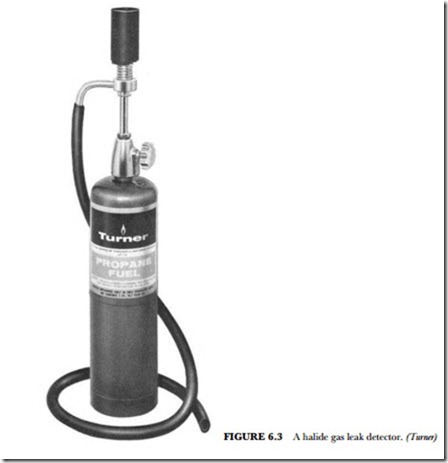DETECTING LEAKS
There are several tests used to check for leaks in a closed refrigeration system. Most of them are simple. Following are some useful procedures:
• Hold the joint or suspected leakage point under water and watch for bubbles
• Coat the area suspected of leakage with a strong solution of soap; if a leak is present, soap bubbles will be produced
Sulfur Dioxide
To detect sulfur dioxide leaks, an ammonia swab may he used. The swab is made by soaking a sponge or cloth, tied onto a stick or piece of wire, in aqua ammonia. Household ammonia may also be used. A dense white smoke forms when the ammonia comes in contact with the sulfur dioxide. The usual soap-bubble or oil test may be used when no ammonia is available.
If ammonia is used, check for leakage in the following ways:
• Burn a sulfur stick in the area of the leak: if there is a leak, a dense white smoke will be produced; the stronger the leak, the denser the white smoke
• Hold a wet litmus paper close to the suspected leak area: if there is a leak, the ammonia will cause the litmus paper to change color.
Freon
Refrigerants that are halogenated hydrocarbons (Freon compounds) can be checked for leakage with a halide leak test. This involves holding a torch or flame close to the leak area. If there is a refrigerant leak, the flame will turn green. The room should be well ventilated when the torch test is performed.
There is also an electronic detector for such refrigerant leaks. The detector gives off a series of rapid clicks if the refrigerant is present. The higher the concentration of the refrigerant, the more rapid the clicks. (See Figure 6.2.)
Carbon Dioxide
Leaks can be detected with a soap solution if there is internal pressure on the part to be tested. When carbon dioxide is present in the condenser water, the water will turn yellow with the addition of bromothymol blue.
Ammonia
Leaks are detected (in small amounts of ammonia) when a lit sulfur candle is used. The candle will give off a very thick, white smoke when it contacts the ammonia leak. The use of phenolphthalein paper is also con- sidered a good test. The smallest trace of ammonia will cause the moistened paper strip to turn pink. A large amount of ammonia will cause the paper to turn a vivid scarlet.
Methyl Chloride
Leaks are detected by a leak-detecting halide torch. (See Figure 6.3.) Some torches use alcohol for fuel and produce a colorless flange. When a methyl-chloride leak is detected, the flame turns green. A brilliant blue flame is produced when large or stronger concentrations are present. The room should be well ventilated when the torch test is conducted. The combustion of the refrigerant and the flame produces harmful chemicals. If a safe atmosphere is not present, the soap-bubble or oil test should be used to check for leaks.
As mentioned, methyl chloride is hard to detect with the nose or eyes. It does not produce irritating effects. Therefore, some manufacturers add a 1 percent amount of acrolein as a warning agent. Acrolein is a colorless liquid (C3H4O) with a pungent odor.
Related posts:
Incoming search terms:
- sulphur candle test
- sulphur candles leak detection
- which method is used in leak detection in sulphur refrigeration system
- methods of detecting refrigrant leakages litmus paper
- Methods of detecting leaks of ammonia refrigerants
- methods of detecting leaks of ammonia
- methods of detecting leakage of ammonia in a refrigerator
- method of detction of ammonia leakage
- litmus paper as a method of refrigerant leak detection
- leakage test of ammonia refrigerant
- leakage of refrigerant by sulphur candle
- methodsofleaktesting ammonia
- mwthod uaed in leak detection of sulphur refrigeration system
- nh3 swab test
- what method is used to detect leak of R717
- what is method of nh3 torch
- what do we use to test ammonia leakage
- use of ph paper detect ammonia leakage
- the leakage in a refrigeration system using ammonia is detected by
- sulphur stick test method
- sulphur cadles in refrigerant
- refrigerant leak detective methods using litmus paper
- leakage of nh3 can be detected by halide torch test
- leakage of ammonia refrigerant is detected by
- explain litmus paper in leak detection
- explain litmus method of refrigerant leak detection
- explain for lick detection of almmonia using a sulfur candles
- detecting leaks language:en
- Describe the methods of leak detection for ammonia as refrigerants
- blue litmus paper is used to detect refrigerant
- amonia swab test for leaks
- amonia refrigerant checked by method
- ammonia leakge testing torch
- explain sulphur candle method of leak detection in refrigeration
- freon leak detector hvac language:en
- Halaide torch
- leak detection of ammonia using sulphur candles
- leak detection methods for ammonia in a refrigeration system
- is burning candle is used for leak detection
- hvac leaks ammonia soa[
- how make halide touch leak test
- hallide torch test and sulphur stick method
- halight toech
- halide torch flame name
- halide lamp used in detecting refrigerant
- ammonia detection leak paper

